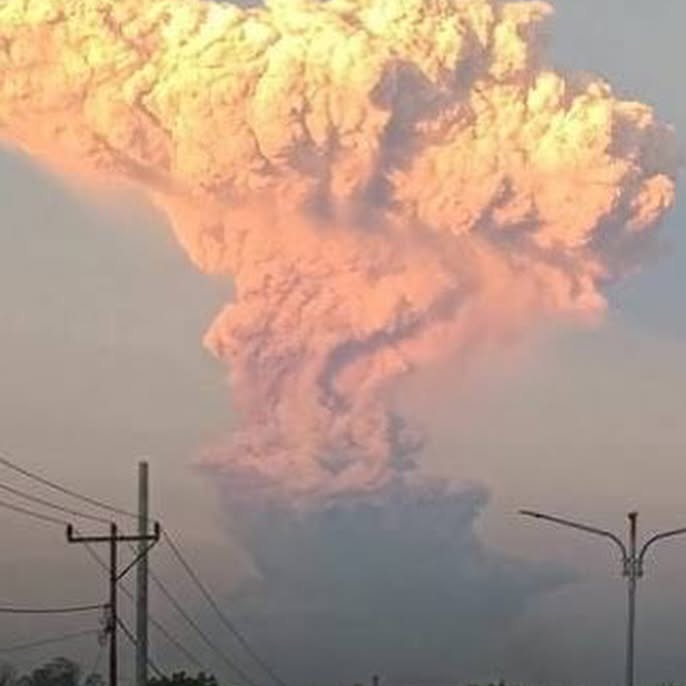Air India Flight Diverted By Bali Eruption
Volcano burst near Bali forces Air India flight mid-route, landing safely in Delhi quickly.

Image: Instagram
On Wednesday, a sudden volcanic eruption near Bali Airport led to a swift decision by Air India to divert its mid-route Delhi-Bali flight back to New Delhi. According to an official statement by the airline, the safety of passengers was the top priority as conditions near the Indonesian airport rapidly deteriorated.
Flight Diversion Initiated
The incident unfolded when a volcanic burst was reported near Bali, causing significant concerns for the approaching aircraft. With the ongoing activity potentially compromising safe landing procedures at Bali Airport, controllers and the flight crew made the decisive move to return the flight to Delhi. Air India’s statement confirmed that the flight, which had already taken off from Delhi, was safely redirected to the National Capital. Passengers were disembarked without incident, and the airline has assured that there were no injuries or further complications.
In a dramatic turn of events during the mid-flight phase, the diversion underscored the unpredictable nature of natural disasters and the readiness of airline safety protocols. The timely decision by Air India not only avoided potential hazards but also exemplified the airline’s commitment to passenger wellbeing. The volcanic eruption, whose active plume was visible on reports and social media images, compelled air traffic controllers to reassess the landing approach immediately.
Passenger Safety First
Military maneuvers and emergency protocols come into play during events such as these. While the passengers on board experienced an unexpected course change, the efficient operations of the cockpit and ground control ensured that the aircraft landed safely in Delhi. Aviation experts note that such diversions, though unsettling, are a testament to rigorous safety standards practiced by airlines worldwide. The incident also sparked a flurry of updates on social media, with notable accounts like Instant Bollywood sharing the unfolding events. Their posts showed images of the turbulent skies and a smoldering volcanic plume, providing a stark visual context to the emergency landing.
The diversion has prompted discussions among frequent flyers and aviation enthusiasts regarding how natural calamities can disrupt travel plans. Commentators have praised the crew’s calm under pressure, as well as Air India’s transparent communication following the event. Passengers on board later described the event as a rare combination of nature’s unpredictability and professional crisis management.
Rapid Response And Industry Implications
As natural phenomena such as volcanic eruptions become more observable due to improved monitoring technologies, airlines are increasingly expected to review and adapt their emergency protocols. In this instance, Air India’s decision to reroute the flight exemplifies both proactive risk management and adherence to stringent safety standards. The diversion not only prevented a potential crisis at the destination airport but also highlighted the importance of timely decision-making in aviation safety.
Officials from Air India have reaffirmed their commitment to passenger security, noting that such decisions, though disruptive, are made with careful consideration of all available data. The airline is currently monitoring the situation closely, and additional measures may be implemented to assist further travel plans in the region.
The unfolding incident near Bali has also brought to light the broader implications for air traffic management in regions prone to natural disasters. Industry experts suggest that improving early-warning systems and communication channels between volcanic observatories and air traffic control can help mitigate similar risks in the future. The collaboration between meteorological agencies, local aviation authorities, and international airlines remains critical in ensuring passenger safety during natural disturbances.
The safe landing in Delhi provides an assurance that despite nature’s forces, prompt action and effective emergency protocols can minimize risks. Both passengers and aviation professionals are set to learn valuable lessons from this experience, further reinforcing the significance of safety measures.
In the wake of the incident, social media channels and news outlets are keeping a close watch on subsequent developments. While the volcano continues to be monitored by local authorities, the overall response from the aviation community has been one of cautious optimism. The entire episode stands as a reminder that while nature is powerful and unpredictable, the measures in place to protect human lives remain robust and reliable.
Read full bio of Glendon Moss

























